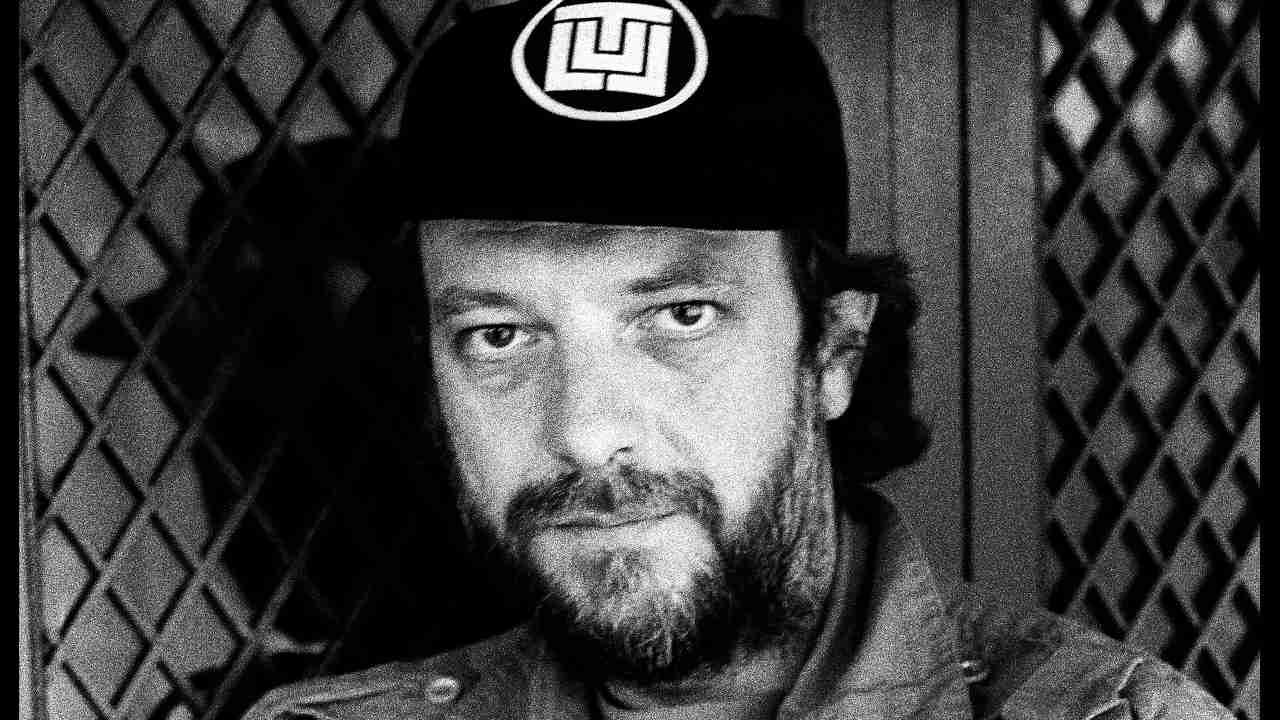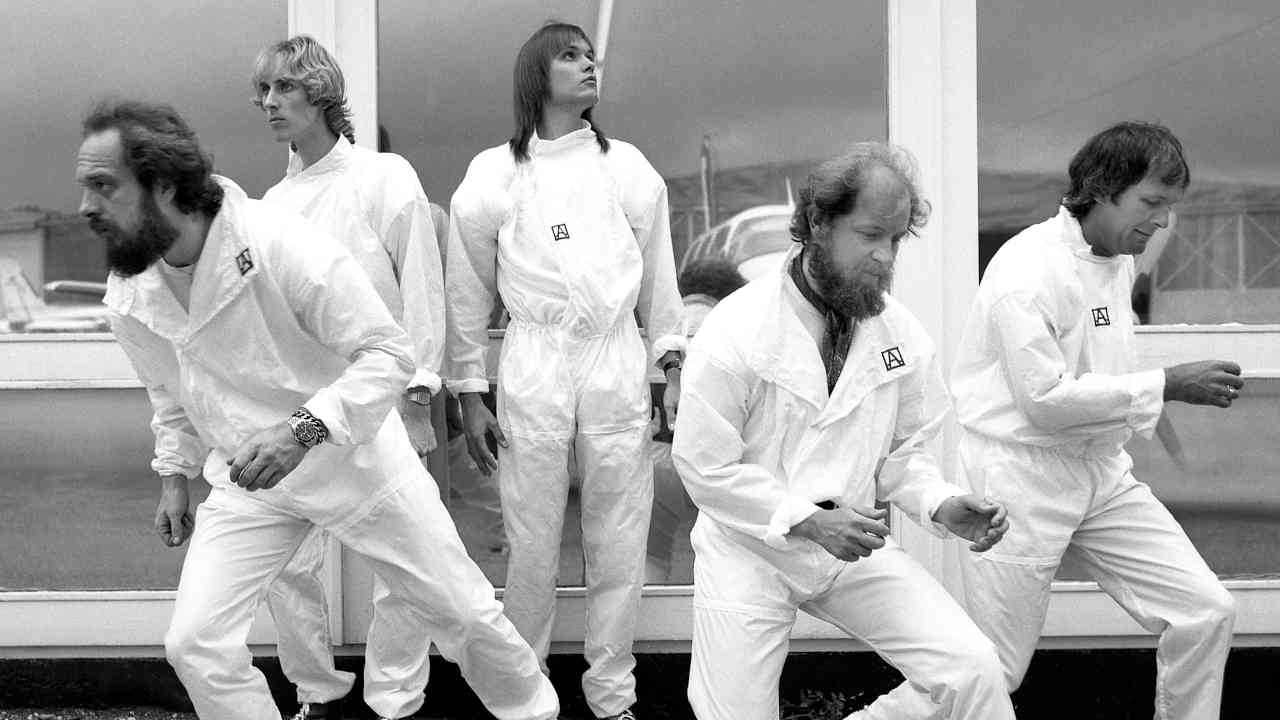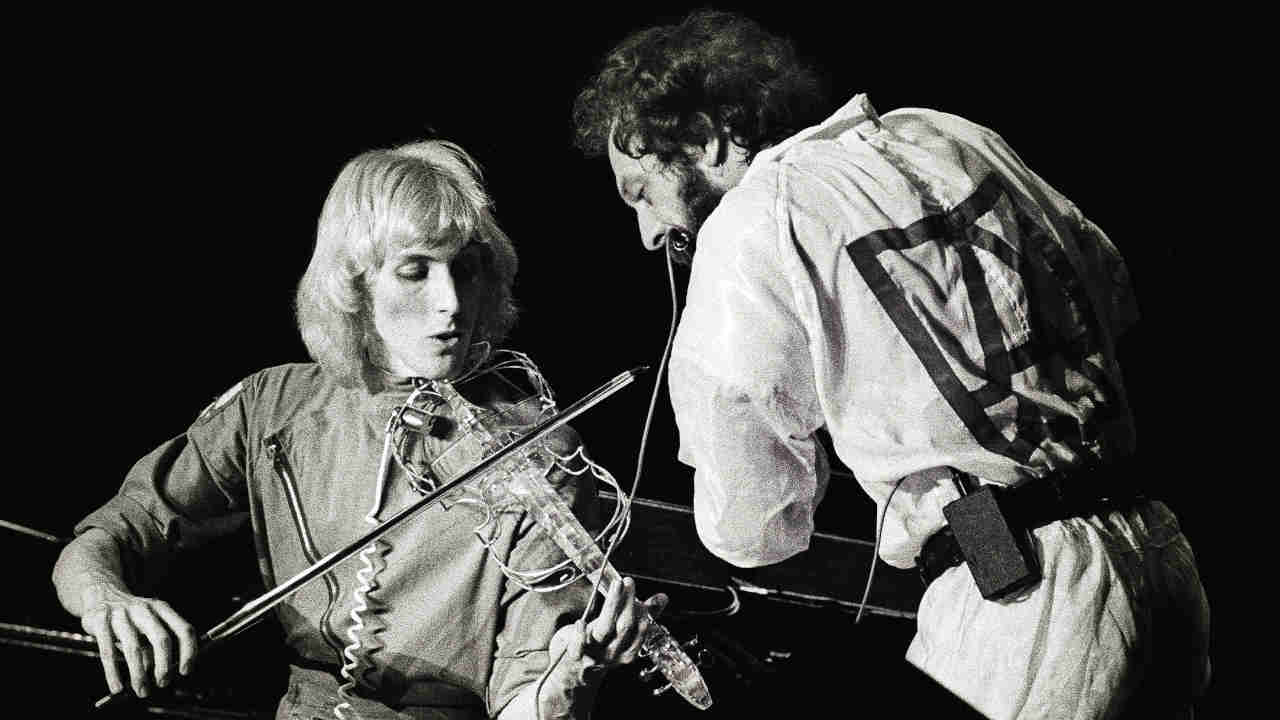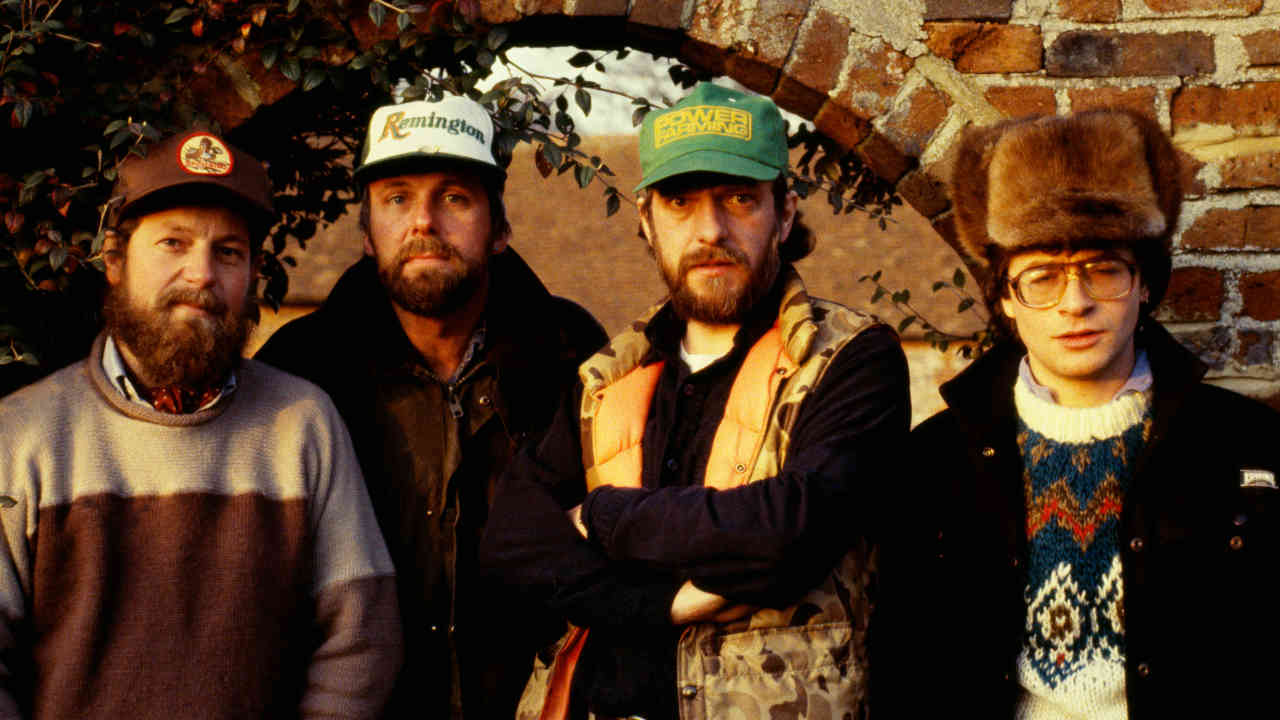
It was two weeks before Christmas 1984 when Ian Anderson finally lost the battle with his own throat. Jethro Tull were on tour in Australia in support of their most recent album, Under Wraps, a record that had caused widespread disgruntlement among fans due to its prevalence of synthesisers, sequencers and, most heretical of all, a drum machine.
The tour was better received than the record, thanks to a stage set that featured the band emerging, literally, from under wraps, along with moonwalking astronauts and women bursting out of large paper bags. For Anderson, though, the shows had been a trial for very different reasons. He had pushed his voice to the edge of its limits in the studio, not realising the toll performing these new songs every night would take on him. By the time Tull reached the US that autumn, his strained larynx was starting to give out, necessitating the cancellation of a handful of gigs.
Rather than pull the subsequent Australian leg, the frontman elected to plough on regardless – a decision he would come to regret. He managed six shows Down Under before it became too difficult to sing. Reluctantly, the remaining gigs were scrapped, along with any further dates in support of the album.
“I absolutely wrecked my voice on that tour,” says Anderson today. “That was really traumatic for me personally and expensive in terms of cancellation and reimbursements to promoters.”
Doctors advised him to rest his voice for several months or risk ruining it completely. In his younger, more bullish days, he would probably have ignored them. But nearing 40, he knew better than to risk it. “I was scared into submission, and decided not to do any concerts for some time to come,” he says. “I think it’s true to say that I’ve never felt my voice was the same again. I’d gone beyond where I should have and really had to settle for second best.”
Anderson’s throat problems would precipitate a lengthy break that effectively sidelined Tull for three years. But it also marked the end of a period that had seen Tull’s leader attempt to drag the band’s sound into the technological age. Even with the benefit of hindsight, the early 80s remains the most controversial era of Jethro Tull’s career - but also the most fascinating.

The 1970s had ended on a downbeat note for Jethro Tull. While the band remained a big live draw, especially in the US, their album sales were slowly slipping – 1979’s foreboding Stormwatch was first Tull record in a decade that failed to make the Top 20 on either side of the Atlantic. On a personal level, they had been rocked by the death of bassist John Glascock, who died as a result of congenital heart problems at the age of 29, while Anderson’s father had also passed away.
“It was a slightly strange time,” says Anderson now. “We had lost John Glascock, my father had died, there were a couple of guys in the band who were starting to get a little restless, the fact that we had come to the end of the decade… So I made the decision to go and do something fresh.”
That ‘something fresh’ was a solo album, one that would allow Anderson to experiment with sounds and styles far removed the genre he had long been associated with. “It was really just a question of having played in Jethro Tull from the late 60s to that point and feeling the urge to try something different.”
The new songs Anderson was writing pivoted away from Jethro Tull’s traditional sound. He was increasingly enamoured by leaps in musical technology and the people utilising it – not least synth-pop star Gary Numan, who Anderson later described as “amazing… I saw him on Top Of The Pops and wanted to hate him, but I realised how important he was.”
“There was always something a little bit new in what Jethro Tull did,” he insists today. “We had used an early AMS Synthesiser on Thick As A Brick. But suddenly at the threshold of the 80s, you had an array of keyboards that could be persuaded to do what you wanted – well, tortured into submission.”
Not everyone was impressed with Anderson’s new direction. “I was dissatisfied with the state of affairs, musically and morally, in Jethro Tull,” drummer Barriemore Barlow later said. “And I thought the new music Ian was writing was not very good.” In truth, Barlow was already agitating to leave the band, telling Anderson that he was putting together a new project, though his departure would come sooner than either party expected.
Anderson’s notional, if temporary, break with the band he had founded wasn’t total. He retained the services of former Fairport Convention bassist Dave Pegg, recruited to replace John Glascock on the Stormwatch tour after the latter was deemed too ill to play. “Dave hadn’t actually recorded with us, he was a Jethro Tull studio virgin, as it were, so I thought I’d ask him to play on these songs,” he says.
But initially his other collaborators were nothing to do with his regular band. The star signing was Eddie Jobson, the former Roxy Music keyboard player and violinist whose recent outfit, UK, had supported Tull on tour. “I asked if he fancied doing some work together,” says Anderson. Jobson agreed, and brought along his friend, American drummer Mark Craney.
The singer and his new colleagues began work on the mooted solo album, titled A (for Anderson), in the summer of 1980 at the singer’s own Maison Rouge studio in London.
“As we started working, I thought, ‘It would be good to have guitar on this song’, so I called [Tull guitarist] Martin Barre, who’s really the only guitarist I know, because I don’t really move in musician circles,” says Anderson. “So he came to work on a song, and then another, and he ended up being on the whole album.”
The presence of Jobson and Craney in the studio alongside Anderson, Barre and Pegg was catnip for music papers looking for an explosive headline. In May 1980, the British weekly Melody Maker ran a front page story claiming that Barriemore Barlow, John Evans and Dee Palmer had been sacked from Jethro Tull. It was dubbed ‘The Big Split’ by the press.
Barlow, for one, was furious. “I went fucking mental,” he later recalled. “Ian had sent a note of apology before it came out, but I thought, ‘Hell, it can’t be that bad.’ But of course it was.”
Anderson refuted claims that the trio had been sacked, insisting that this new line-up was a one-off and that Jobson and Craney were purely guest musicians, to little avail. It didn’t help that Chrysalis were pushing him into releasing A under the Jethro Tull name.
“At that point it was sounding less like a solo album and more like a band album. And technically it had three members of Jethro Tull on it. So when the record company heard the music they were reluctant to go down the route of it being a solo album. I allowed my arm to be twisted to release it as a Jethro Tull album, which was a mistake and a disservice to the other guys who had been in the band because they suddenly felt they were now no longer members.”
The decision to record with outsiders had hastened the departure of Barlow. John Evan and Dee Palmer followed him out of the door.
“I wrote to the other guys, saying, ‘Listen, I’m afraid is this is coming out as a Jethro Tull album’, and tried to apologise – badly,” says Anderson. “But obviously they were upset and they never came back.”

The state of confusion surrounding this latest incarnation of Jethro Tull was nothing compared to the reaction of longtime fans who heard A when it was released at the end of August 1980. The cover image – the band in lab coats, gazing out of the window of what could have been a spaceship – at least gave fair warning as to what to expect.
Gone was the elemental approach of the recent ‘folk trilogy’, while the grandstanding prog rock of Thick As A Brick was nowhere to heard. Lyrically, Anderson was as scalpel-sharp as always, but the plinking keyboards of Crossfire and Batteries Not Included were less Kraftwerk, more Kraft cheese. There were moments of brilliance, notably the twisting Black Sunday, although the folksy The Pine Marten’s Jig felt like a sop to the devotees.
The subsequent tour was no less of a shock to the system. Anderson insisted that the band appear on stage in Devo-like white jumpsuits, looking like a bunch of befuddled lab technicians who had wandered into the wrong venue. “It was an absurd idea, made worse by the fact that these things instantly became transparent as soon as you sweated in them,” says Anderson now.
The exception was Eddie Jobson. “Eddie had made it very clear that he was a guest musician, that he wasn’t a member of the band, and he was billed as such. He insisted on having a jumpsuit in a different colour so he stood out from everybody else.”
While band were well drilled, fans were less than convinced. It was Jobson who was the butt of their ire, at least according to Anderson.
“They didn’t much like Eddie,” the singer says today. “He was a little bit too preening. He had that Brian Eno thing about him, and our crowd had totally hated Roxy Music when they opened for us at Madison Square Garden years before. There was definitely a change in temperature from the audience, but it wasn’t aimed at the band as a whole – they just didn’t like Eddie.”
In truth, they didn’t much like what Jethro Tull had become either. If this was the sound of the future, Ian Anderson could keep it.
If the singer hoped people saw A the same way as he did – as a bold, experimental one-off – he would be disappointed. His next move would be to edge slightly back towards safer ground.
To replace Evan and Palmer, Anderson recruited a young keyboard player who would help give focus to his new musical explorations. The 26-year-old Peter-John Vettese was a former member of jazz-fusion band Solaris who joined Jethro Tull after spotting a classic ‘musician wanted’ advertisement in Melody Maker.
“Peter was energetic, full of life. And he hailed from my part of the world, which was Scotland,” says Anderson now.
Vettese’s attributes were more than just geographical. He was musically astute and knowledgeable in the new technologies that Anderson was interested in. Vettese signed up for Tull in time to work on the band’s 14th album, The Broadsword And The Beast, and his impact was immediate.
“He was very quick to grasp a musical idea and try to get to the nub of it. And he didn’t waffle around noodling with different sounds. He always had an idea as to how we would get to a certain point fairly quickly where we settled on a particular musical line.”
If A was the sound of Ian Anderson stepping out of his comfort zone, then the follow-up found him rowing at least partially back into it. The electronic flourishes of A were still there, augmented on some tracks by a drum machine (though flesh and blood new recruit Gerry Conway did most of the heavy lifting drum-wise), but it was offset by a windswept Celtic atmosphere, exemplified by the epic sweep of the track Broadsword.
“At the time I was living some of the year on the Isle Of Skye, in the wilds off the west coast of Scotland, facing the sea,” says Anderson of the song. “In times gone by, the Viking longships came up the sea lochs of Scotland to pillage and plunder and generally have their wicked way with the locals. And so it was just this notion of sometimes standing on a headland and imagining this longship coming up the loch.”
The Broadsword And The Beast got a better reception from fans than its predecessor when it was released in April 1982. Certainly, it was a more confident record. Songs like Beastie, Pussywillow and Slow Marching Band – the latter of which could be read as a dig at the departed Barriemore Barlow, though Anderson has denied it – bridged old and new Tull, though the band’s more intractable followers were still having none of this new-fangled technology (a pair of outtakes from the album, Jack Frost And The Hooded Crow and Jack A Lynn, were much more in tune with the band’s 70s sound, though they were conspicuously kept in the vaults for another decade).
Still, any affinity for the album was strengthened by the subsequent tour, which found Anderson cheekily playing out his Viking fantasies. A mock-longship was part of the stage set, while the singer wielded an eight-foot broadsword with impressive deftness. It wasn’t all ninth century theatrics, though – during Watching Me Watching You, a group of roadies in white coats trooped onstage, eventually joined by a man in a giant rabbit suit.
If the job of The Broadsword And The Beast was to restore fans’ faith in Jethro Tull, it worked, But its commercial impact was mixed.
“The Broadsword And The Beast was our most successful selling record in Germany ever, yet it was a dead duck in the USA,” says Anderson. “It’s not like it was just as simple as the fact that Americans didn’t like the sound of those songs. It had to do with a lot of the realities of the music business: the change in American radio, even the move from radio into MTV, which didn’t work terribly well for Jethro Tull.”

If the album’s reception in America had been disappointing, at least Anderson’s newfound musical partnership Peter-John Vettese was proving fruitful. Such was the pair’s rapport that Anderson elected to take another run at a solo album, this time with the keyboard player’s help.
“The expectation was for it to be the solo record that A turned out not to be,” he says. “I wanted it to be a bit more sparse, and the idea of just doing it between the two of us seemed like a more attractive thing. And that’s the way we made the album, really – just the two of us.”
Released in 1983 and credited to Anderson, Walk Into Light was more radical than anything the singer had put his name too before, including A. The cover – a newly-shorn Anderson framed by stark, Test Card-style imagery – gave some indication of its musical direction. This was more Ultravox than Jethro Tull, an album of stark, largely electronic songs. Putting aside the provenance of the man whose name is on the cover, it’s a surprisingly assured record, the likes of Fly By Night and Made In England pointing forward to a brave new future.
“I could have made an album of me singing and playing the flute, but that seemed too obvious,” Anderson later recalled. “I wanted to get away from what I was known for.”
That certainly worked – perhaps too well. Jethro Tull fans ignored Walk Into Light in their droves. Anderson had finally scratched the solo itch, though if anyone thought he had got his fascination with new technology out of his system, they would be mistaken.
The singer reconvened Jethro Tull in the Spring of 1984. “Suddenly becoming a band again was nice after having done an album that was rather more sparse and down in feel, as the solo album had been,” he says.
But there was one notable absence. For the first time in their career, Jethro Tull were recording an album without a drummer. Instead, Anderson had elected to use a new LinnDrum drum machine, then at the cutting edge of digital tech. “It was a regular session, except for the fact there wasn’t a drummer present,” says Anderson.
Where The Broadsword And The Beast had felt like a welcome compromise towards fans, there was no such effort made with Under Wraps. It might have been a Jethro Tull album in the way that A wasn’t, but its synthetic approach marked it out as a logical successor to Walk Into Light rather than TBATB.
“To most Tull fans the idea of us sounding like a cross between The Police and Thomas Dolby was a little bit of a stretch in credibility,” says Anderson. “The fact was, we did it rather well, Not as well as The Police and Thomas Dolby, perhaps, but you know, rather well.”
Today, Under Wraps is widely regarded as the worst Jethro Tull album, a reputation that’s not entirely deserved. While its sound and production date-stamp it to the mid-80s, the songs and themes running through it – “spies, secrecy and subterfuge,” according to Anderson, inspired by his love of writers such as John le Carré and Ted Allbeury – were classic Tull. An acoustic version of the title track, featuring Dave Pegg on stand-up bass, and released on a 2005 reissue of, pulls back the synthetic curtain to reveal the beating heart of Anderson’s music.
“The one regrettable thing about that album is that wretched drum machine relentlessly boring a hole in your skull, because it’s got some great songs on it,” says Ian Anderson. “And it was one of Martin Barre’s most inspired moments of guitar playing. I think in a way he felt that he didn’t have to worry about keeping time with a drummer who was never perfect. All he had to worry about was playing the right notes.”
Predictably, Under Wraps didn’t go down well among the Tull faithful. For Anderson, a more worrying matter was the loss of his voice on the subsequent tour. After the cancelled Australian tour, he returned to the UK to focus not on the band but on his trout farms in Scotland, and “recharging his spiritual batteries.”
It would be almost three years before Jethro Tull fully returned to the fray. When they did, with 1987’s Crest Of A Knave, it was in much altered form – or at least a form that was more recognisable to longtime fans of the band. The album largely dialled back the electronic diversions of the 80s, replacing it with a warm, earthy sound that echoed contemporary giants Dire Straits, not least on the album’s highlight, the slow-burning 10-minute epic Budapest.
Crest Of A Knave was an unexpected success, selling more than a million copies in the US and famously, beating Metallica to a Hard Rock/Heavy Metal Grammy Award. More importantly, for Tull fans it successfully wiped away the memories of what many saw as an aberrant dalliance with technology Jethro Tull had no right to be using. Today, Anderson remains aware of the flaws of the albums he put out in the early 80s. But there’s also a stubborn pride to the way he views them.
“You could be a Luddite and ignore these new instruments, or you could say, ‘Well, let’s give it a spin, let’s see what it’ll do.’ And so I chose the latter course,” says Anderson. “You have to push the boundaries sometimes.”







